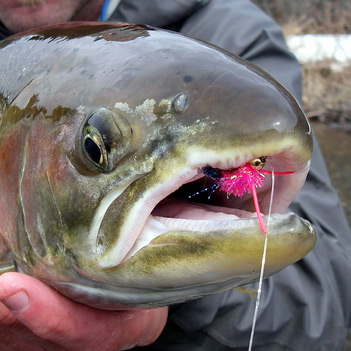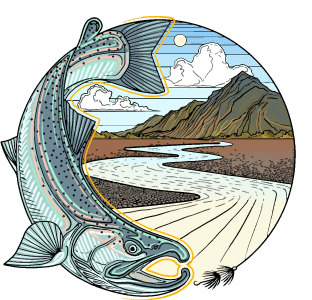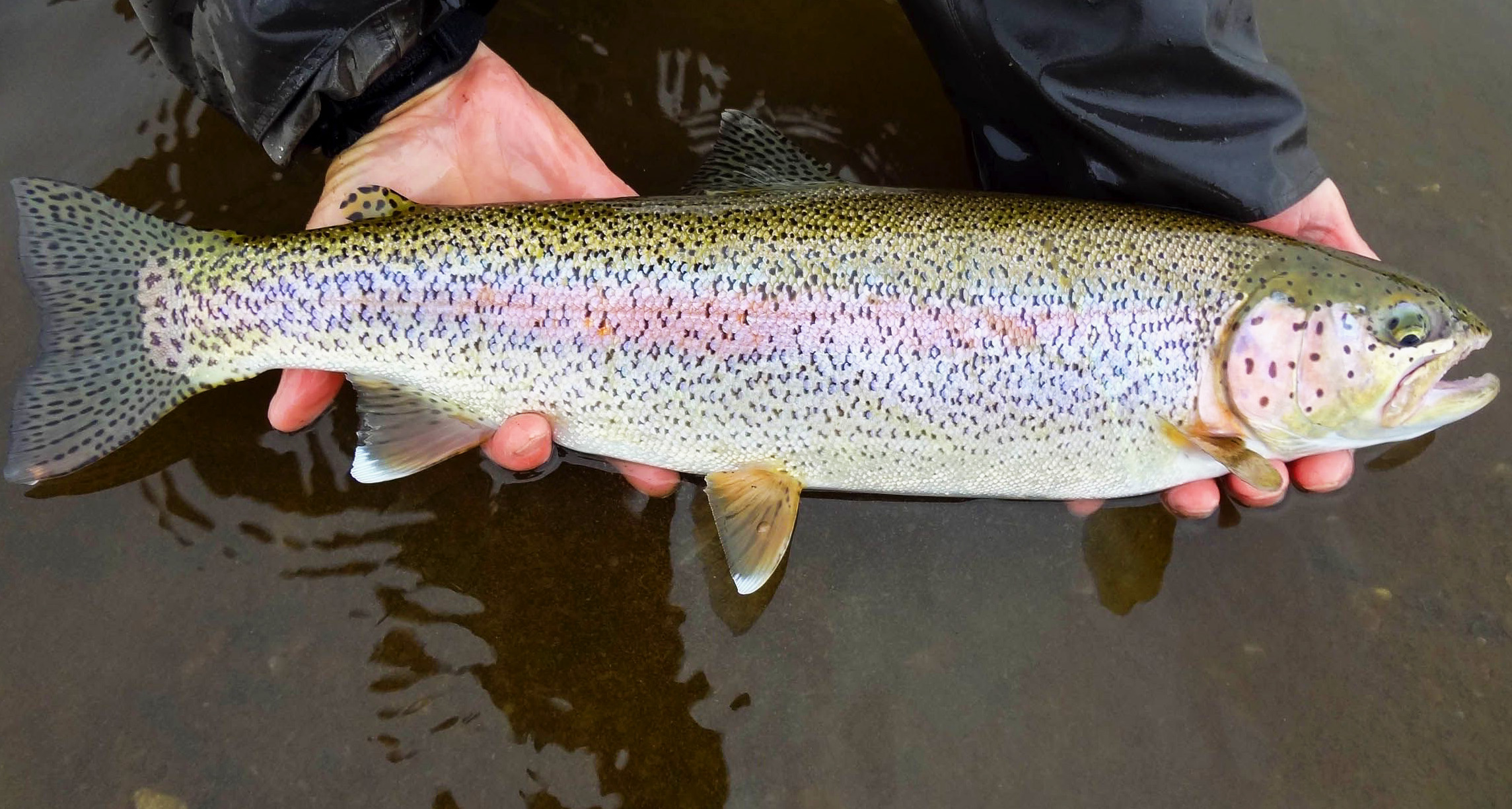 Spring is in the air, and the prospect of wetting a line for steelhead is right around the corner. Last winter's snow is melting off nicely, making for perfect river conditions to welcome the first fish of the year. You spent all of last month futzing around with gear, making sure your reel drags are working properly and getting your fly rods in order, checking and re-checking your gear bag to make sure that you haven't forgotten anything. You read the last issue of The Drake and got all jazzed up to go fishing, and this year you finally got one of those "Steelhead Nymph Selection" boxes from AFFG. You are pretty much ready to go fishing, but there's one more thing...how does all this stuff go together, anyways?
Spring is in the air, and the prospect of wetting a line for steelhead is right around the corner. Last winter's snow is melting off nicely, making for perfect river conditions to welcome the first fish of the year. You spent all of last month futzing around with gear, making sure your reel drags are working properly and getting your fly rods in order, checking and re-checking your gear bag to make sure that you haven't forgotten anything. You read the last issue of The Drake and got all jazzed up to go fishing, and this year you finally got one of those "Steelhead Nymph Selection" boxes from AFFG. You are pretty much ready to go fishing, but there's one more thing...how does all this stuff go together, anyways?
THE BASIC IDEA
Many of the steelhead streams in Alaska are fairly small (<600cfs), high-gradient flows with lots of woody debris, and these conditions lend themselves well to the dead-drifted presentation. The basic principle behind the dead-drift is that the fly is cast straight across or slightly upstream of the angler and allowed to drift at the same speed as the current or "dead", usually near the riverbottom. Dead-drifting is usually performed with a floating line and a weighted fly meant to imitate either local insect nymph stages (hence the term "Nymphing") or various other forms of organic matter found in riparian environments, such as salmon eggs or flesh. The ideal dead-drift keeps the fly on a parallel path in the current to maintain a life-like presentation of the offering.
When dead-drifting, it is very important to avoid excessive movement of your offerings once a drift is set up. In some situations this cannot be helped, but in most fishing scenarios the "life-like" illusion can be destroyed by too much line drag, causing your fly or bead to go swimming in a direction contrary to the current. As a general rule, salmon eggs and tiny insects don't swim fast or at all in the natural environment, and these motions might set up red flags for wary steelhead eyeing a potential meal. To combat line drag, mend upstream immediately after the cast and then as needed to keep your offering moving at the same speed as the current.
Dead-drifting can be accomplished with or without the use of a strike indicator, which is a small float placed on the leader and intended to aid in the detection of subtle takes. Recently, the trend has been to abandon all pretense of "indicator" and treat the device as a bobber to maintain presentation depth. To achieve a dead-drift with this type of setup, the angler need only to mend line to the indicator to prevent it from dragging in the current.
THE BASIC SETUP
Basic nymph rigs are pretty simple; they consist of a fly, a weight, and a leader/tippet, all fished off the end of a floating fly line. However, within the outward simplicity lie a few subtle details that are key elements in the proper workings of the rig. We'll go over a few details on each component, starting with...
The Fly
Most steelhead nymphs are of the weighted variety, employing either lead base-wraps or some type of weighted head. When fishing with these flies, it is often unnecessary to add more than a very small amount of weight to your rig, as the fly does a fine job of sinking into the strike zone all by itself.
There are also some popular steelhead patterns that are unweighted or very lightly weighted, such as glo-bugs, beads, and Neon Shrimp. When using un- or lightly-weighted flies, a weight of some sort is necessary to deliver your offering to where the fish live. That brings us to...
The Weight
When used correctly, a weight accomplishes 3 objectives: it speeds the delivery of your fly into the strike zone, it helps keep your fly in the strike zone throughout the drift, and it acts as a "damper" or disconnect, preventing unwanted movement of the fly line from transiting the leader and altering the drift of your fly.
There are a few different choices when it comes to weights, but most fall into 2 groups: split-shot, and putty products. Split shot are relatively easy to use, fairly self explanatory, and inexpensive. On the down-side, they tend to snag on rocky bottoms, they slip off easily, and in the case of lead shot, they are toxic.
Putty weights are a fairly new arrival, and they consist of a temperature-sensitive, pliable material that is impregnated with tungsten powder. At around body temperature the putty becomes soft, allowing it to be molded around your line. When you dip it in the water, it hardens up and keeps it shape. Putty weights are a little more expensive, but if used correctly they are hardly ever lost, they don't snag as easily, and they are environmentally friendly, as well as being legal in waters that lead weights are prohibited.
Whichever lead you choose, put it on your leader slightly above the tippet / leader connection, closer than 24" but further than 15" from the fly. Speaking of leaders...
The Leader/Tippet
The leader/tippet combo should do a few things - it should deliver your fly to sufficient depth, it should be stout enough to land big fish quickly to prevent mortality, and it should be stealthy enough to not set off alarm bells for every fish in the river.
For the depth part of the equation, an easy rule of thumb is to fish a leader that is 1 to 1½ times the water depth. In Southeast Alaska most situations are covered with a 7-foot leader, but it is always wise to have enough leader material to make a longer section if need be, or to replace a broken or damaged leader.
For strength, we would recommend a leader with a breaking strength of 15-20lbs. Tapered leaders will work, but you will have to deal with a little bit of additional line drag from the upper, "fat" end of the leader. An easy alternative to a tapered leader is a single-step leader, made with a single size of monofilament.
Stealth is one of the many keys to success in steelheading, and an easy way to make your terminal tackle stealthy is to use fluorocarbon for your tippets. Nearly invisible in water and quite a bit heavier than monofilament, fluorocarbon has the added advantages of higher abrasion resistance and less stretch than most monofilaments. On the downside, most fluoro is more expensive than mono, is non-biodegradable, and tends to be a little "fussier" when it comes to knots. The "Fluoro v. Mono" argument has been going on for years now, but we prefer fluoro for the simple reason that higher pound-test line can be used without the fish seeing it. The higher the pound-test, the faster you can land a hooked fish in heavily-wooded pools. This translates to fewer stressed fish, which means less fish mortality.
TO BOBBER OR NOT TO BOBBER?
There are a few important factors to take into consideration when deciding whether or not to use a strike indicator in your nymph rig. If you are fishing smaller water (<200cfs) or shallow riffles and slots with even flow bank-to-bank, an indicator might not be necessary. If you are fishing larger, wider flows, or fishing over uneven flows (seams, backeddies, boulder runs), then an indicator can be a great tool to keep your offering moving at the correct speed. Occasionally, wary fish in relatively calm water can "go off the bite" when an indicator is used, but it is rare that the indicator will spook fish. If you use a brightly-colored indicator, quite the opposite might happen...a hungry fish might pass up your small fly and rise to the surface to take a whack at the indicator!
There are many different types of indicator on the market today, but for all-around ease of use, floatability, and casting ability, our go-to indicator is the Thingamabobber. Whatever your choice of indicator, it is best to put it on the leader right at the leader/fly line junction. This prevents any loss of control caused by the sinking of the leader in between the indicator and the fly line.
AS THE KIDS SAY, ANOTHER WAY TO ROLL
The single fly / long leader setup is a very productive method of nymphing, but there is another way to nymph for steelhead that is equally effective. The two fly / short leader rig allows an angler to fish well off the bottom, losing a minimal amount of time to hang-ups and gear changing. In addition, the angler gets to present two different flies or beads to the fish, so in a sense you are covering the water twice with each cast. When calm and undisturbed, steelhead will readily rise in the water column to take an offering, so the chances of foul-hooking or lining a fish are greatly diminished with the two fly / short leader rig. The Flies
The Flies
When selecting flies for the two fly rig, it is best if the flies are on different ends of the scale in their attributes. Large/small, bright/dark, flashy/subdued...you get the picture. You can tie them on in whatever order you wish, but the best way to rig is with the lightest fly lowest. This allows the lighter fly to "float around" below the heavy fly, and results in fewer hang-ups.
To connect the bottom fly to the top fly, use an improved clinch knot on the hook-bend of the first fly, with 12" to 20" of tippet material. The tippet between the flies should be 2 to 4lb test lighter than the main tippet - in the event of a hang-up, this way you only lose one fly.
The top fly is connected to the tippet and the tippet is connected to the leader in the same manner as for the single fly rig. The same weighting principles are involved in both rigs, but the two fly / short leader rig has the added advantage of being fished without the weight contacting the bottom, allowing for heavier weights which further control and minimize the movement imparted by the fly line.
The Leader
As the name implies, the two fly / short leader rig uses a...wait for it...short leader. With the use of heavy weight the rig tends to be much more vertical in the water column, and since the distance between the weight and the bottom fly can often be 3' or so, a leader over 4' is often unnecessary. For most applications, a leader length of 2' to 4' is needed, and in most situations a single-step leader of 15 to 20lb test is sufficient.
The Indicator (or Bobbercator)
Unlike the single fly rig, the two fly / short leader rig is heavily dependent on the use of an indicator to work correctly. As stated before, this rig is designed to fish vertically in the water column, suspended under a float of some variety. Once again, our choice is the Thingamabobber, an easy-casting, high riding indicator. An added bonus to the two fly / short leader setup is the exciting grabs it cause - because the fish move off the bottom to take the flies, the indicator signals the "eat" not by merely stopping or hesitating, but by being jerked violently under the surface.
A QUICK NOTE ON METHODS AND MEANS
As with all types of fishing, nymphing is not strictly limited to the aforementioned rigs or traditional steelhead nymphs. If you are in an adventurous mood, try dead-drifting a large sculpin pattern for steelhead, or fishing a string-leech under an indicator - you might be pleasantly suprised.
While an angler shouldn't limit themselves to the type of water they nymph, they should exercise caution and conservation around paired or spawning fish. In the small stream environments of Southeast Alaska, the steelhead runs are generally short, intense affairs, and the angler fishing for moving fish will occasionally encounter pre-spawn pairs of fish. Spawning takes place primarily in tailouts and flat gravel fans, leaving these fish exposed as they attempt to finish what they came here to do. Steelhead often survive spawning, albeit in a very weakened state, so they are consequently very alert, wary creatures - except when they are spawning. While these fish may seem easy to approach and will readily take a fly, PLEASE, please don't cast at spawning fish. Most runs of steelhead in Southeast Alaska number in the few hundreds at best, so while practicing catch and release with fresh, moving fish is ethically acceptable, fishing for spawning fish is not. Remember, if they didn't have a safe place to spawn, we wouldn't have any steelhead. Also, when moving up and down your favorite steelhead stream, be aware of where you step - those same tailouts that make for easy river crossings often have unoccupied redds (spawning beds). While the adult fish may have gone, the eggs are still there under the gravel, and are easy crushed by the careless wader.
Steelhead are often called "the fish of 10,000 casts", and are an exciting and rewarding game fish to pursue with fly tackle. Nymphing is a great way to get your feet wet in the steelhead game this year in Southeast Alaska, so come on...what are you waiting for?
GEAR WE LIKE:
| Rods: Sage 790-4.890-4 Sage Pulse 790-4, 890-4 Winston Biiix 890-4 Winston Nexus 790-4, 890-4 Echo Boost 890-4 Switch Rods: Sage One 7116-4 Sage Pulse 7114-4, 8114-4 Echo 3 Switch 7110, 8110 Echo SR 71010. 81010 Redington Duelly 7119-4, 8119-4 Reels: |
Lines: Rio Grand Rio Single Handed Spey Airflo Nymph/Indicator Line Switch Lines: Rio Switch Rio Switch Chucker Weight: Good old fashioned split shot Loon "deep soft" putty Twist-ons Indicators: Thingamabobber Yarn indicators Leaders: |
Flies: AFFG Steelhead Nymph Selection MoneyBug Liquid Wrench Egg Sucking Stone Fish Emission Egg Steelhead Glo Bug Neon Shrimp Roegain Copper Swan Beads (Size 10-14mm) Disco Balls Guide Model Steelhead Beads Mark's Metalhead Magnets GLS Beads Mottled Trout Beads (10-14mm) Bead Hooks: |




